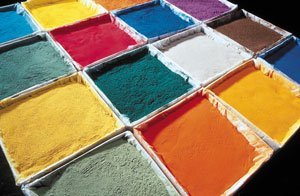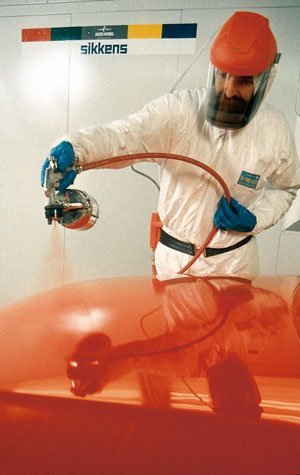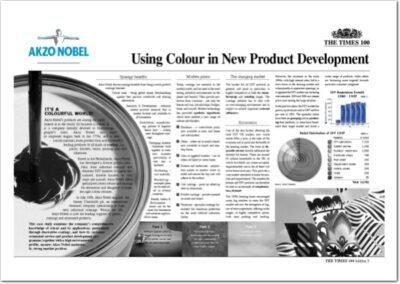
It’s a colourful world!
Akzo Nobel’s products are among the most looked at in the world. Its business is colour. It is a company literally devoted to brightening people’s lives. Akzo Nobel can trace its corporate origins back to the 1770s and is now a multi-national, multi-product firm and the world’s leading producer of all kinds of coatings, i.e. paints, finishes, stains, printing inks and adhesives.
Based in the Netherlands, Akzo Nobel has developed a diverse product portfolio, from industrial coatings and domestic DIY markets, to highly specialised, durable finishes on cars, ships and aircraft. Akzo Nobel offers specialised colour advice and training for decorators and designers to make the right colour choices.
In July 1998, Akzo Nobel acquired the former Courtaulds plc, an international chemical company specialising in high-tech industrial coatings. Within the UK, Akzo Nobel is now the leading supplier of paints, coatings and associated products.
This case study examines the company’s comprehensive knowledge of colour and its applications, particularly through decorative coatings, and how its customer orientated service and product development programme, together with a high environmental profile, ensures Akzo Nobel maintains its strong market position.
Synergy benefits
Akzo Nobel derives synergy benefits from being a multi-product coatings business:
- Critical mass – being global means benchmarking against best practices worldwide and sharing information.
- Research & Development – technical centres provide research that is market focused and available to all businesses.
- Distribution, manufacturing, process & logistics ‘know how’ – widely used throughout coatings.
- Emerging markets – businesses work together to enter new markets particularly if one has a foothold.
- Purchasing – raw materials.
- Marketing – concepts/ plans can be replicated in several countries.
- Health, Safety & Environment – issues can be the same for businesses and solutions are applicable to many.
Modern Paints

Today, coatings are essential to the modern world and are used in the most testing industrial environments on the planet and beyond. They provide protection from corrosion – not only for homes and cars but also ships, bridges, trains and aircraft.
Modern technology has provided synthetic ingredients which have enabled a new range of colours and finishes:
- Emulsion – a water-borne paint, now available in matt, mid sheen and silk finishes.
- Gloss – either oil or acrylic-based, now available in liquid and non-drip forms.
- Satin or eggshell finishes – can be either oil-based or water-borne.
- Primers and undercoats – preparatory paints to protect wood or metal and ensure the top coat will adhere to the surface.
- Coil coatings – paint on rolled-up steel or aluminium.
- Powder coatings – powder sprayed on metal and baked.
- Woodcare – specialist coatings formulated for maximum protection on the most difficult substrate, timber.
The changing market

The market for all DIY products in general, and paint in particular, is highly competitive at both the manufacturing and retailing stages. The coatings industry has to deal with an ever-changing environment and is subject to several important external influences.
Economics
One of the key factors affecting the total DIY UK market, now worth nearly £8bn a year, is the state of the economy and in particular the health of the housing market. The level of disposable income directly influences the demand for houses. There are around 24 million households in the UK, of which two-thirds are owner-occupied. Approximately one in ten of these will move house each year. This provides a core market interested in home decoration and improvement. The markets for houses and DIY products can therefore be seen as an example of complementary demand.

The 1980s housing boom encouraged many big retailers to enter the DIY market and saw the emergence of big, out of town superstores, offering wider ranges, at highly competitive prices, with easy parking and loading. However, the recession in the early 1990s, with high interest rates, led to a slowdown in the housing market and subsequently in superstore openings, as it appeared the DIY market was becoming over-saturated. 1993 and 1994 saw intense price wars among large retailers.

In the past two years, the DIY market has grown; up seven per cent in 1997 and five per cent in 1998. The specialist stores have been re-grouping and re-positioning their products, i.e. some have broadened their target market and stock a wider range of products, while others are becoming more targeted towards particular customer categories.
Social changes
A number of factors are responsible for this recent upswing in home improvements: consumers have become more sophisticated and more demanding, DIY is no longer perceived as a ‘man’s job’ or a mere necessity, and the growth in media interest in the home improvement market reflects this shift in consumers’ attitudes. Recent television programmes, such as ‘Home Front’ and ‘Changing Rooms’, have emphasised effects that can be achieved simply and more cost-effectively by being imaginative, often encouraging short-term changes of colours. The focus is on creative makeovers rather than major rebuilds. Viewing figures for these programmes, broadcast at peak times, have doubled and they follow the trend set by home interest magazines which were first on the scene. Sales of these magazines have more than doubled in the last ten years, combined circulation has more than quadrupled and there has been an increase in advertising.
Environment

The market for paint has also been affected by concerns about environmental issues from the public as well as the legislator. Akzo Nobel puts a strong emphasis on product stewardship: the company designs or modifies its coatings with health and safety in mind and to minimise the environmental impact over their complete life cycle, from the choice of raw materials, through manufacturing, distribution, use and disposal. Water-borne, radiation curing, or powder coatings, as well as high solids, contain fewer solvents than conventional paints or even none at all, at the same time they provide a high functionality.
Akzo Nobel is committed to constantly improving its performance in the field of safety, health and environment. To this end, the company has joined the chemical industry’s Responsible Care and the coating industry’s Coatings Care programmes. The purpose of these voluntary initiatives is to integrate permanent health, safety and environmental management (HSE) procedures into the company’s everyday activities through the use of a consistent set of management practices.
Colour forecasting – it’s FASHION all the way

Not only does Akzo Nobel have to deal with factors beyond its control in terms of external influences, but also the internal market is always changing. One of the main determinants of demand is ‘taste’. The taste for different colours is subject to trends, and therefore predicting what is going to be the next fashionable colour range is crucially important to the manufacturer.
Timing is critical; bringing out a new colour range too early can be as costly as being too late. Different ranges will have different product life cycles; pure brilliant white emulsions and gloss paints will have a very long, possibly infinite life cycle, while coloured matt and silk emulsions might last between two and ten years. Paints aimed at the high fashion markets may peak for two years or so before their popularity fades.
Research into the business of colour is becoming increasingly scientific. Colour affects moods and feelings. A pink kitchen encourages people to be more sociable, but a bathroom needs to be peach to reduce tension and help relaxation. Hospitals need to be painted orange or red to create an atmosphere of warmth to help patients relax. In its purest form, colour therapy is considered by some to be a branch of alternative medicine, offering relief from problems as diverse as anxiety, depression, asthma, insomnia and pain relief.
Recently, there has been a colour explosion in new areas, for example, the traditional ‘white goods’ such as fridges and cookers which use coil coatings. This dramatically increases consumer choice; even domestic lighting now uses coloured powder coatings.
There is a great deal of interaction with the world of fashion, which will also affect the markets for soft furnishings and accessories. This has been encouraged by a number of fashion designers launching their own interior ranges, often taking their inspiration from the latest catwalk fashions. And Akzo Nobel’s architectural coatings business, Sikkens, has invited famous architects to define their colour schemes for the new millennium: ‘New colours for a new century’.
To date Alessandro Mendini and Sir Norman Foster have provided their colour sets. To understand what its customers are looking for, Akzo Nobel undertakes both quantitative and qualitative research. Akzo Nobel’s aim is to produce consistently in all its coatings businesses’ product ranges with a strong sense of brand, performance, image and appeal, spanning the decorative, architectural, automotive, aerospace, powder, coil, marine and yacht coatings sectors and inks.

Crown period colours, successful decorative product development
Akzo Nobel identified a new trend – consumers wanting to give older properties an original authentic period feel, or give newer properties a feeling of age. When put into the context of a growing interest in antiques and popular period dramas on television, this added up to a clear marketing opportunity as, although it was possible to buy such paints, they were very expensive and difficult to obtain.
Akzo Nobel developed and launched Crown Period Colours in a compact colour range to make choice easier and made it available to the mass market at an affordable price. The range is distributed through DIY superstores and was specially formulated to give the authentic flat matt finish. The colour shades were given historically evocative names, and even the can was specially designed to give it an antique look.
Crucial to the success of the product launch was the photography used for the brochures and point-of-sale material in store, which have created much consumer interest.
Conclusion

With predictions of continued growth in the highly competitive decorative market, Akzo Nobel needs to respond quickly to all changes in conditions to remain the market leader. The market for DIY products is subject to external influences, due to its close relationship with the housing and fashion sectors. Historically, the housing market is one of the first sectors of the economy to be affected by a downturn in economic activity and can therefore be said to be highly income elastic.
Some external influences are predictable, to a greater or lesser extent, or will take some time to form. Others can come out of the blue. Careful analysis of all the relevant markets enables the company to forecast some trends. At the same time, Akzo Nobel operates in markets that are fiercely competitive.
At Akzo Nobel, the process of forecasting fashion in colour and the subsequent product development programme enables branding with an emphasis very much on the image. Flexibility and adaptability are key to success in marketing these products.
 Critical Path Analysis at Network Rail (PDF)
Critical Path Analysis at Network Rail (PDF)  Using colour in new product development (PDF)
Using colour in new product development (PDF) 